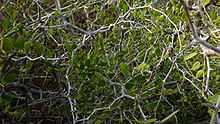Ziziphus lotus
| Ziziphus Lotus | |
|---|---|
 | |
| Scientific classification | |
| Kingdom: | Plantae |
| (unranked): | Angiosperms |
| (unranked): | Eudicots |
| (unranked): | Rosids |
| Order: | Rosales |
| Family: | Rhamnaceae |
| Genus: | Ziziphus |
| Species: | Z. lotus |
| Binomial name | |
| Ziziphus lotus (L.) Lam. | |
Ziziphus lotus (Jujube) is a deciduous shrub in the buckthorn family Rhamnaceae, native to the Mediterranean region, including the Sahara in Morocco. The name of the plant in Cyprus is palloura (greek:παλλούρα) or konnarka (greek:κονναρκά) and it is described on page 47-48, volume 11 of Μεγάλη Κυπριακή Εγκυκλοπαίδεια (1990).
Description
Ziziphus lotus can reach a height of 2–5 metres (6.6–16.4 ft), with shiny green leaves about 5 cm long. The edible fruit is a globose dark yellow drupe 1–1.5 cm diameter called a nabk. Common names in Arabic are sidr, rubeida ("after its crouch-shaped treetop"), nbeg in Tunisia and annab in Lebanon.[1]
It is closely related to Ziziphus jujuba (jujube), and is often regarded as the lotus tree of Greek mythology.[2]
References in literature
Ziziphus lotus is thought to be referenced in the Odyssey, consumed by the Lotus-Eaters as a narcotic to induce peaceful apathy.
See also
References
- ↑ Amots Dafni, Shay Levy, Efraim Lev (2005). "The ethnobotany of Christ's Thorn Jujube (Ziziphus spina-christi) in Israel". Journal of Ethnobiology and Ethnomedicine 1 (8): 8. doi:10.1186/1746-4269-1-8. PMC 1277088. PMID 16270941. Retrieved 2010-06-05.
- ↑ Herodotus, Histories, Book IV, 177.